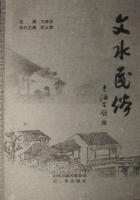The thorax is smooth, the wing cases large, folded under the body like a scarf and coming almost to the middle of the abdomen. This has nine segments, of which four, starting with the second, are armed, on the back, down the middle, with a belt of little horny arches, pale brown in color, drawn up parallel to one another, set in the skin by their convex surfaces and finishing at both ends with a hard, black point. Altogether, the belt thus forms a double row of little thorns, with a hollow in between. I count about twenty-five twin-toothed arches to one segment, which gives a total of two hundred spikes for the four rings thus armed.
The use of this rasp, or grater, is obvious: it gives the nymph a purchase on the wall of its gallery as the work proceeds. Thus anchored on a host of points, the stern pioneer is able to hit the obstacle harder with its diadem of awls. Moreover, to make it more difficult for the instrument to recoil, long, stiff bristles, pointing backwards, are scattered here and there among the climbing belts. There are some besides on the other segments, both on the ventral and the dorsal surface. On the flanks, they are thicker and arranged as it were in clusters.
The sixth segment carries a similar belt, but a much less powerful one, consisting of a single row of unassuming thorns. The belt is weaker still on the seventh segment; lastly, on the eighth, it is reduced to a mere rough brown shading. Commencing with the sixth, the rings decrease in width and the abdomen ends in a cone, the extremity of which, formed of the ninth segment, constitutes a weapon of a new kind. It is a sheaf of eight brown spikes. The last two exceed the others in length and stand out from the group in a double terminal plowshare.
There is a round air hole in front, on either side of the thorax, and similar stigmata on the flanks of each of the first seven abdominal segments. When at rest, the nymph is curved into a bow.
When about to act, it suddenly unbends and straightens itself. It measures 15 to 20 millimeters long and 4 to 5 millimeters across.
Such is the strange perforating machine that is to prepare an outlet for the feeble Anthrax through the Mason bee's cement. The structural details, so difficult to explain in words, may be summed up as follows: in front, on the forehead, a diadem of spikes, the ramming and digging tool; behind, a many bladed plowshare which fits into a socket and allows the pupa to slacken suddenly in readiness for an attack on the barrier which has to be demolished; on the back, four climbing belts, or graters, which keep the animal in position by biting on the walls of the tunnel with their hundreds of teeth; and, all over the body, long, stiff bristles, pointing backwards, to prevent falls or recoils.
A similar structure exists in the other species of Anthrax with slight variations of detail. I will confine myself to one instance, that of Anthrax sinuata, who thrives at the cost of Osmia tricornis. Her nymph differs from that of Anthrax trifasciata, the Anthrax of the mason bee, in possessing less powerful armor. Its four climbing belts consist of only fifteen to seventeen double spiked arches, instead of twenty-five; also, the abdominal segments, from the sixth onwards, are supplied merely with stiff bristles, without a trace of horny spikes. If the evolution of the various Anthrax flies were better known to us, the number of these arches would, I believe, be of great service to entomology in the differentiation of species. I see it remaining constant for any given species, with marked variations between one species and another. But this is not my business: Imerely call the attention of the classifiers to this field of study and pass on.















